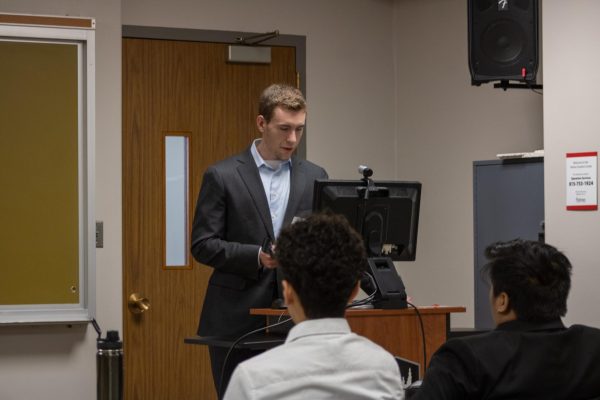Students interested in medeival times can receive a degree concentration
February 2, 2009
Amongst the knights and gargoyles in Susan Deskis’s office, on a bookshelf next to copies of the centuries-old poem “Beowulf,” are several miniature duck and rabbit figurines.
“They’re from Monty Python and the Holy Grail,” the associate English professor said, before using a mini-catapult to sling one of the ducks at the shelf’s interior. “My brother gave me that.”
While “Holy Grail” was a parody of medieval times, Deskis takes that era quite seriously. She teaches courses focusing on the time period, which stretched from 500 to 1500 A.D. and is a co-coordinator of the Medieval Studies concentration. As it’s the university’s only interdisciplinary concentration, undergraduate students of any major can take it, though they must at least be a sophomore and have a 2.0 GPA.
Though only a handful of students graduate with the concentration each year – 3 to 6 on average, Deskis said – many others could be well on their way to completing it without even realizing it. They can even use classes they’re already taking for their major or minor: “double dipping,” as Deskis calls it.
“My freshman year, in my history class, my professor said ‘you’re halfway towards getting the concentration.’ It was the logical course to get the concentration,” said senior history major Amber Croy, who got an amusing reaction when she told her friends and family of her new educational venture: “My parents are like, what the heck is this?”
Croy added that the concentration is “truly interesting stuff. It’s something for everyone.”
Senior English major Liz Evans took the concentration because she was interested in finding out what life was like back in medieval times. She’s glad she did.
“I took a trip to England. It was cool to see things that you read about,” she said, adding that she can now point out historical inaccuracies while watching movies set in the middle ages to “annoy” her friends. “It’s neat to have this knowledge. I can whip it out at a party.”
Deskis, who’s surrounded by books and interspersed figurines as she sat in her third-floor Reavis Hall office, talked about how she would recommend that people of any major give the concentration a try. That’s because they’re not likely to find out about medieval studies the way she did: “I had a Medieval Literature instructor who looked like a Viking,” she said.
“The biggest misconception is, because it’s not recent, they’re not going to like it,” she said of prospective students. “They think it’s dry and boring, whereas it’s exciting in terms of having a lot of action. … If people give it a chance, they find out they can relate to it more than they expected.”
As for the collection of miniature swords, gargoyles and knights adorning her office, she explained: “Being a medievalist, people give me toys. I like toys.”
What’s that you’re studying?
What: The Medieval Studies interdisciplinary concentration. It focuses on all aspects of culture from 500-1500 A.D., including literature, history, music and architecture, said co-coordinator Susan Deskis. An introductory and a capstone medieval studies course are required. Upon completion, students receive a certificate, and it is acknowledged on their transcripts, Deskis said.
Who: Undergraduates with any major or minor can take it, given that they are at least a sophomore with a GPA of 2.0 and up.
Where: Classes in the 21-hour concentration are from the disciplines of English, history, art history, Latin, German, Spanish, music, philosophy, political science and theater.
Why: “No matter what your major is, it makes a student look more well-rounded,” Deskis said.
How: Contact Deskis at 815-753-6626 or [email protected] for more information. Students will need approval from a coordinator to take the concentration. (The program’s other two coordinators, Nicole Clifton and Valerie Garver, are on leave.)












